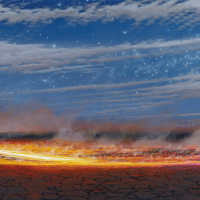17. TIM STORRIER

Tim Storriers painting is born from his ability to isolate a moment in time and infuse it with intense detail. Storrier paints expansive and pared-back scenes of the Australian landscape that he executes with painstaking precision. His compositions sing with impeccable draughtsmanship and vivid colour. Storrier is not overly forthcoming when asked to delve deeper into what drive his work and he is likely to respond in the following way, well, thats none of my business, you work it out.1
One can only assume it is a lifelong affinity with the land that drives his practice. At the age of four Storrier moved from Sydney to Umagarlee, the family property near Wellington in the Central Western district of New South Wales. In 1964, when Storrier was away at school in Sydney, his father Austin acquired another property near Coolah. Storrier would travel for hours, to and from school, examining the landscape and embedding images in his imagination. In 1995 he moved to Backdown, a property near Bathurst and in 2009 built a substantial studio flanked by cavernous windows allowing views of his sprawling garden. Now, Storrier resides at Hopewood in Bowral, an oasis he has occupied since 2013. It is important to note that throughout his lifetime Storrier has explored the far-flung corners of the globe venturing to the Middle East, Europe, Asia and Antarctica, yet he returns to his subject, the Australian landscape time and again making it inherently his own.
Storrier works with four key elements: land, stars, fire and air and their relationship to infinity. The limitless combination of these elements encompasses his practice, and each slight tweak to the formula delivers a vastly different experience. The Night (Chrome Tap) 2008 is an exquisite example of Storriers art. A molten pool of flames oozes forward, its path seeming to travel a great distance from the horizon line. The molten pools cracked lid blackens as it cools, mimicking the cracked earth beneath.
The sky, occupying two thirds of the composition is littered with celestial clusters, piercing the blanket of blue that is banded by clouds that meld with, and are the colour of the smoke. The fire appears to be glowing, pulling the viewer into the landscape, holding their attention. Fire is primal. Our relationship to it is ambiguous, as it is the source of life and death. The present work is devoid of human beings, and as John McDonald has noted the inclusion of flames acts as evidence of their recent occupation.2
The resolution of The Night (Chrome Tap) is startlingly fierce and beautiful. Photographic perfection is not what Storrier strives for, and although it is inherent, he paints from memory and imagination, noting Whether I am painting a bottle or a sunset, it has more to do with mood, memory and the distillation of time than realism.3 Storrier is both a surveyor and custodian of the Australian landscape. His work accesses an interior world of dreams, but it is the lifelong affinity Storrier has with the Australian landscape that drives him.
Footnotes:
1. Lumby, C., Tim Storrier: The Art of the Outsider, Craftsman House, Sydney, 2000, p.11
2. McDonald, J., Tim Storrier: In Absentia [exhibition catalogue], Australian Galleries, Melbourne, 2010, n.p.
3. Tim Storrier, quoted in Klepac, L. Tim Storrier, The Beagle Press, Sydney, 2018, p.39
Clementine Retallack